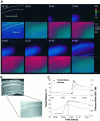Imaging spreading depression and associated intracellular calcium waves in brain slices
- PMID: 9736642
- PMCID: PMC6793239
- DOI: 10.1523/JNEUROSCI.18-18-07189.1998
Imaging spreading depression and associated intracellular calcium waves in brain slices
Abstract
Spreading depression (SD) was analyzed in hippocampal and neocortical brain slices by imaging intrinsic optical signals in combination with either simultaneous electrophysiological recordings or imaging of intracellular calcium dynamics. The goal was to determine the roles of intracellular calcium (Ca2+int) waves in the generation and propagation of SD. Imaging of intrinsic optical signals in the hippocampus showed that ouabain consistently induced SD, which characteristically started in the CA1 region, propagated at 15-35 micrometer/sec, and traversed across the hippocampal fissure to the dentate gyrus. In the dendritic regions of both CA1 and the dentate gyrus, SD caused a transient increase in light transmittance, characterized by both a rapid onset and a rapid recovery. In contrast, in the cell body regions the transmittance increase was prolonged. Simultaneous imaging of intracellular calcium and intrinsic optical signals revealed that a slow Ca2+int increase preceded any change in transmittance. Additionally, a wave of increased Ca2+int typically propagated many seconds ahead of the change in transmittance. These calcium increases were also observed in individual astrocytes injected with calcium orange, indicating that Ca2+int waves were normally associated with SD. However, when hippocampal slices were incubated in calcium-free/EGTA external solutions, SD was still observed, although Ca2+int waves were completely abolished. Under these conditions SD had a comparable peak increase in transmittance but a slower onset and a faster recovery. These results demonstrate that although there are calcium dynamics associated with SD, these increases are not necessary for the initiation or propagation of spreading depression.
Figures









References
-
- Andrew RD, MacVicar BA. Imaging cell volume changes and neuronal excitation in the hippocampal slice. Neuroscience. 1994;62:371–383. - PubMed
-
- Andrew RD, Lobinowich ME, Osehobo EP. Evidence against volume regulation by cortical brain cells during acute osmotic stress. Exp Neurol. 1997;143:300–312. - PubMed
-
- Charles AC. Glia-neuron intercellular calcium signalling. Dev Neurosci. 1994;16:196–206. - PubMed
-
- Charles AC, Dirksen ER, Merrill JE, Sanderson MJ. Mechanisms of intracellular calcium signalling in glial cells studied with dantrolene and thapsigargin. Glia. 1993;7:134–145. - PubMed
Publication types
MeSH terms
Substances
LinkOut - more resources
Full Text Sources
Miscellaneous
